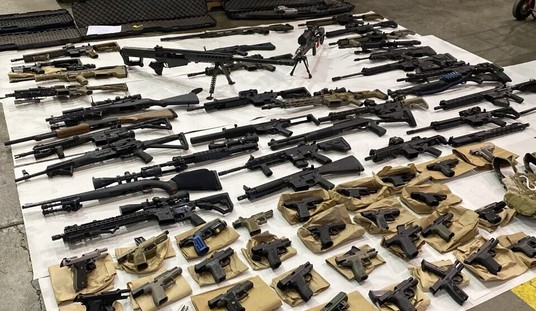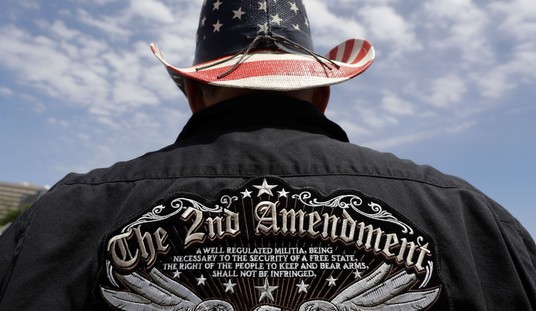The recent tragedy of a 9 year-old girl accidentally killing a supposed instructor with a Mini-Uzi raises many issues, including the proper firearms and methods for introducing young children to shooting. Fortunately, the family of the man who died, 39 year-old Charles Vacca, have been understanding and forgiving, and in truth, it was not the fault of the 9 year-old. She and her family will have to live with a trauma to which they should never have been exposed.

By all means, take the link and view the short video, shot by the girl’s relatives. The very rapid cyclic rate of the Mini Uzi is plainly audible, and a significant contributing factor to the tragedy. So, apparently was Vacca’s lack of instructor credentials and experience, as noted in the article at the link.
Comments relating to this incident on Bearing Arms and elsewhere make clear that few people understand machineguns—and submachine guns in particular—and their proper employment. In the hope of correcting that lack of general knowledge to at least some degree, I present this brief submachine gun primer.
As to my background to discourse on this subject, regular readers know of my general firearms, military and police background. Those experiences, as well as an intense but not obsessive interest in firearms have allowed me many opportunities to study, fire, and above all, to clean, and examine many of the submachine gun designs currently on the market. I’ve also a reasonable amount of practical experience with common general purpose (AKA medium), and a few heavy machine guns. I also hold an instructor’s certification for submachine gun from the American Small Arms Academy.
Keep in mind from the outset that most of what the public thinks it knows about submachine guns from TV and the movies is wrong, dangerous, and grossly ineffective. Unlike the shoot from the hip and spray and pray methods Hollywood favors, and unlike the unlimited magazine capacity full-auto shoot fests often portrayed on the silver screen, submachine guns are most effective when fired from the shoulder, when the sights are used, and when fired in two to three rounds bursts. There are potential uses for extended fully automatic fire, but they are relatively uncommon, particularly in police work.
Fully automatic weapons, including electrically driven miniguns, may be owned by individuals, but not without substantial restrictions and bother. Americans tend to have little personal submachine gun experience because in 1986, Democrats, through legislative chicanery, added a ban on all machine guns to the Firearm Owner’s Protection Act. Only those weapons legally possessed and registered with the federal government prior to May 19, 1986 are still lawful. This means that no citizen may own or transfer a machinegun of any kind manufactured after May 19, 1986 (18 USC 921 ). Law enforcement may, of course, purchase new weapons. As one might imagine, this has created a seller’s market.
Submachine guns may be generally understood to be relatively compact, short-barreled, shoulder fired small arms firing pistol cartridges, and capable of semi and full automatic fire. There are various subcategories and variants of this description. Some weapons add burst capability, or substitute it in place of fully automatic capability, and there are even a few fully automatic pistols, such as the Glock 18–which looks nearly identical to the Glock 17, and the Beretta 93R.

Because they fire pistol cartridges—most commonly the 9mm and .45 ACP—and because they generally have short sight radiuses and short barrels, effective submachine gun range is usually considered to be no more than 100 yards, and optimum employment is at common pistol ranges. Obviously, various red dot or laser sights may be helpful with submachine guns, as they are with many firearms, but most submachine guns, particularly first and second generation models, were not designed to be equipped with this sort of accessory.
[article continues on next page]

Assault rifles are often mistaken for submachine guns. The most common assault rifle variant in America is the AR-15 family. Police agencies, even citizens, own semiautomatic civilian versions of the military M4. Anti-gun activists and the media have often tried to confuse the issue by representing these semiautomatic rifles as machine guns, actually writing in their internal documents that if it looks like a machine gun, they can trick people into thinking it’s a machinegun. No doubt this principle goes a long way toward explaining why the media love to trumpet the involvement of an AR-15 in any kind of shooting or crime, even when none were involved. AR-15 variants fire an intermediate rifle cartridge, and therefore, if capable of automatic fire, are assault rifles, not submachine guns. Semiautomatic rifles, by definition, are not assault rifles, or “assault weapons”–there is no such thing–as the media and anti-liberty activists would have us believe.

First generation submachine guns employ old-world manufacturing methods and materials. They tend to be expensive and time and labor intensive. Perhaps the best-known first generation submachine gun is the Thompson, in its 1928 incarnation, and later, in the WWII era M1 version which while still too costly, was cheaper than the 1928. It saved money by omitting bluing, an adjustable rear sight, the compensator, the ability to mount drum magazines, an easily detachable butt stock, the finned barrel, and the internal Blish lock. The Blish lock was a device that was said to reduce recoil and smooth the action, but having owned a model 1928, and fired others, including many M1 Thompsons, I’ve never been able to detect any difference in performance or feel.

Despite what some might consider flaws, the Thompson was prized by those who carried it in combat. It is still in use around the world. Its moderate cyclic rate of around 600 RPM is considered ideal by many and makes firing bursts of two and three rounds easy by trigger manipulation alone.

Second generation submachine guns make use of stamped and spot- welded metal rather than machining, using machined parts such as the bolt only when absolutely necessary. This not only greatly reduces manufacturing costs, but greatly accelerates the manufacturing process.

They are truly the products of mass production, requiring little or no hand fitting. Common examples of second-generation weapons are the British Sten and Sterling, and the US M1 “Grease gun” and Smith and Wesson M76. These weapons tend not to be pretty, but they work.
[article continues on next page]

Another feature of second-generation weapons is the suppressor, usually not as an integral part of the design, though some integral designs were produced. These second generation designs tended to be less than long-lasting, and were not nearly as efficient at sound suppression as contemporary designs.

It should be noted that there is no such thing as a “silencer.” However, some contemporary suppressors are very efficient and effective, and most help to provide an enhanced, much cooler gripping surface for the off-hand on weapons that tend to overheat.

Third generation submachine guns continued the trend of second generation weapons in using folded, stamped and welded metal, but added a telescoping bolt that when closed encompassed some length of the barrel. This allowed a much shorter, lighter and more compact weapon while maintaining a reasonable barrel length. Folding and/or retracting stocks also contributed to shorter weapons, but often at the expense of a proper stock length. This is not such a problem for people of smaller stature or those wearing thick tactical vests or body armor.

Common third generation weapons are typified by the excellent Uzi and its several variants, such as the Mini-Uzi and the Micro-Uzi.

Is there such a thing as a fourth generation submachine gun? If so, the Kriss Super V may be the first of the breed. Ultimately, it may be too early to declare a specific fourth generation. The Kriss employs several unique design and manufacturing features. Making extensive use of plastics, and employing a unique recoil-reducing mechanism, the gun’s appearance is unlike any other submachine gun and is also designed to accept now commonly available accessories. A variety of odd-looking stock designs tried by the manufacturer may be encountered. Employing the .45 ACP cartridge, the Kriss might be considered to be a logical evolution of the Thompson, while fixing its drawbacks. The Kriss is far lighter, more ergonomic, much more compact, and more adaptable to a variety of missions.

[article continues on next page]
Virtually all first, second and third generation submachine guns were not designed to easily accept accessory sights. This is in large part so because when they were originally developed, such things either didn’t exist or were in their developmental infancy. However, various mounts are now available for most popular submachine guns.

One of the most iconic contemporary submachine guns, the Heckler and Koch MP5, combines features of second and third generation weapons.
Submachine guns fire from either an open or closed bolt. An open bold mechanism is, particularly for arms intended to be used in combat and subject to sustained automatic fire, necessary. If the weapon becomes too hot–and this happens incredibly rapidly under sustained fully automatic fire–rounds can “cook off,” or be detonated merely by contact with the chamber, which can be dangerous indeed if the bolt is not fully closed at the time. This can produce shrapnel from exploding cartridges, an exploding weapon, a runaway gun, or all three. A pull of the trigger releases a large and heavy bolt to fly forward under heavy spring pressure, stripping a cartridge from the magazine, guiding it into the chamber and firing it. This movement disturbs accuracy, though with correct technique and practice, this problem can be minimized.
The MP5 uses a roller locking system and fires from a closed bolt. While this is, to the way of thinking of many, an overly complex mechanism, it is undeniably effective and tends to enhance accuracy because when the trigger is pulled, there is no heavy bolt slamming forward to disturb aim. The MP5 family can overheat if fired on automatic for extended periods, but because these weapons tend to be used in the counter-terror and SWAT roles, extended fully automatic fire is not generally and issue. The good ergonomics, overall quality, and accuracy of the MP5 contribute to its popularity.

As previously mentioned, a cyclic rate of around 600 RPM is generally considered to be a good balance between effectiveness and controllability. However, when a design is downsized, such as the Mini or Micro Uzi or various versions of the MP5, and the weight of the bolt is also downsized, the cyclic rate increases, reaching 1000 RPM or even more. There are, of course, other factors, such as ammunition and design features that influence cyclic rate, and a high cyclic rate is not necessarily a bad thing, but, combined with small size and short barrels, a high cyclic rate poses problems for inexperienced or untrained shooters.
The purpose of submachine guns–and machine guns–particularly in the military context, is to provide a high volume of fire on objects that will expose themselves only momentarily, increasing the probability they’ll be hit. In combat, and in counter terror and police applications, submachine guns are particularly effective in close quarters battle, indoors or outdoors. In such situations, it’s important to be able to place multiple rounds of accurate fire on multiple targets to immediately incapacitate them. Properly employed, submachine guns work well.
With few exceptions, submachine guns should be fired from the shoulder, the sights should be used, and trigger control should be accomplished not with mechanical burst regulators, but by the educated and experienced trigger finger of the operator. Movie shooting—firing from the hip, wildly swinging the muzzle with the weapon on full auto, firing one-handed—is guaranteed to empty magazines in seconds and entirely miss one’s target while ventilating the surrounding landscape to no effect, other than damaging property and shooting innocents. And of course, real weapons do not have unlimited supplies of ammunition in a single magazine.
Even a 600 RPM submachine gun will empty a 30 round magazine in about two seconds of fully automatic fire. A 1000 RPM gun will empty a magazine much more quickly. Bursts of two to three rounds manipulated by the trigger finger are easily achieved with proper training and practice. However, with high cyclic rate weapons, this becomes more difficult and demanding.
There are many misconceptions about submachine guns. One of the oldest tropes is that the muzzle of the Thompson on full-auto will climb uncontrollably, up and to the right. Nonsense. The Thompson is a ten-pound shoulder arm firing a pistol cartridge. While the laws of physics can’t be repealed, with proper technique, the contents of a 30 round magazine can be easily fired into a paper plate at reasonable engagement distances. The same is true for virtually any submachine gun.
Pistol ammunition fired from the longer barrels of submachine guns tends to outperform the same ammunition fired from pistols. This, as well as a higher hit probability with multiple rounds, accounts for much of a submachine gun’s effectiveness.
[article continues on next page]
But all of these factors make the employment of small submachine guns, like the Mini Uzi, dangerous for the inexperienced. Such weapons have short and not particularly ergonomic stocks, light weight, very short barrels, slight gripping space for the off-hand, and a very high cyclic rate. Some have no stock, relying on slings and/or fore ends for stability. Not properly controlled, such weapons will experience extraordinarily rapid, even violent, muzzle climb due to their high cyclic rate. They are expert’s weapons and should not be fired by neophytes, particularly beginning shooters with limited physical strength. In fact, it would not be a wise idea to allow such people to fire even a ten+ pound Thompson because they lack the physical strength to support and fire it properly.
These were the problems facing Charles Vacca and the 9 year-old girl. What’s the appropriate firearm for a slight, female beginner? A bolt-action .22 rifle, fired from a supported position would be a wise choice. Such a configuration not only eliminates strength issues, it makes learning the fundamentals, such as cheek weld, sight alignment and trigger manipulation, easier. Most importantly, it maximizes safety, making it difficult to swing the muzzle in the wrong direction, and of course, shooting from a support, and particularly with a .22, recoil is not an issue.
Contrast this with a Mini-Uzi fired unsupported. While such a weapon is not too heavy for even an adult female, it is surely too heavy and inherently unstable for a slight 9 year-old girl. It is not an intuitively ergonomic weapon. Every factor of firing the weapon is against the child shooter, who, having no firearm experience, would have no way to control the high cyclic rate of the gun, and upon firing, would tend to squeeze and hold the trigger down in a death grip as physics took over and forced the muzzle in unpredictable directions with predictably tragic consequences.
Physically, morally and legally, the girl is not in any way responsible. It is the responsibility of adults to anticipate the limitations of children in the shooting sports or any other sport, and to take affirmative steps to ensure they or others won’t be needlessly injured.
It is not unreasonably to assert that submachine guns are more potentially dangerous than some other firearms. However, as with any firearm, this potential danger can be mitigated. The first step is recognizing that movie shooting is just that, and submachine guns have unique qualities that require cautious, properly trained and experienced teachers and operators.
Mike’s Home blog is Stately McDaniel Manor.







Join the conversation as a VIP Member